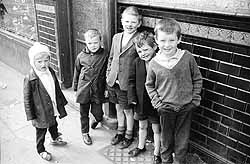
| HOME |
| NERVE |
| REVIEWS |
| ARCHIVE |
| EVENTS |
| LINKS |
| ABOUT US |
| CONTRIBUTORS |
| BACK ISSUES |
| CONTACT US |
 The
Long Way Home
The
Long Way Home
Bernard Fallon
Liverpool Conservation
Centre (3rd March – 15th July 2007)
Reviewed by Hana Leaper
“I took these pictures an amateur in the true sense of the word, not only because I wasn‘t paid to do them but also that I loved the sensation of events and scenes materialising in the viewfinder”
The photos in the exhibition document the changing urban landscape and social environment on and around the bus route from Crosby to the city centre. All were taken between 1967-1975, most in the years 1969-1970.
Fallon’s style is informed by that of Henri Cartier-Bresson’s photographic journalism and the extant display brings a documentary clarity to the ordinary Liverpool lives not usually associated with the Capitalized events of HISTORY. Notions of ‘scouse-ness’ unfold before the lens, untainted by the sentimentalized values of big-budget televisual representations. Fallon captures a moment/space somewhere between pose and reality, closest to the recall of memory and presents a form of ‘social realism’ in which the subjects speak for themselves, unsubsumed by class politics or value judgement.
This is my Gran’s Liverpool; my parent’s childhood. School children with cheeky freckled faces and dirty knees could be them. The women in their headscarves could be her. The room echoes with exclamations of ‘I remember that’, or ‘I remember him’ and it isn’t hard to get people talking about what the display means to them. Taking a rest on the bench next to me, Harry Parker, on his first visit to the Conservation Centre with his son points out friend’s old homes he recognizes, delighting in detailing the journeys of his past.
Anne Moule of Southport and Joyce McCabe of Litherland stopping in front of pictures of Great Homer Street Market tell me “I hated Paddy’s Market – my Mum used to take me every week’. They describe the exhibition as ‘terrific, detailed and evocative’, and were especially drawn to ‘Pub, Scotland Road’, the photo of the beefburger stand, and ‘Five Kids’.
Neil Beet – a security guard in the Conservation Centre – has been listening to viewer’s stories. He has heard that ‘Pub, Scotland Road’ was taken in The Honky Tonk and of the many young men and only two women featured, many have now passed away. He also reveals:
‘…the other day a woman came in and started to cry when she saw the picture ‘Shawlie and Husband’. It was her Grandparents, now passed away and she had no idea about the picture. And the ‘cheeky’ lads have been in to see their portrait which was used as promotional material – they still look as cheeky!’
Neil recognises the Crosby baths ice cream man in one picture and describes his big red van held together with Walls stickers.
Some images are discomfortingly rough; ‘Beer’ shows a man passed out on the grass of the Grand National car park. ‘Black Eye’ depicts four young men sat in the tiny room of an Islington doss house, one is slumped, almost doubled over in his chair, back to the camera; the central figure’s handsome, Sean Beanish face distorted by a closed over, blackened right eye. Human figures are often dwarfed by the bleak industrial scale of construction work or demolitions. But there are frequent flashes of character and humour as in ‘Make us Famous and ‘Curlers’ showing a cleaner with her curlers in. There are no glamorous portraits and some pictures have a feeling of desperation about them – e.g. ‘Ciggies’ – but the reaction of the many viewers, especially the people whose era this was, is punctuated by laughter.
Comments:
Comment left by Bernard Fallon on 26th June, 2007 at 16:40
Dear Hana,
Thanks for your lovely review. You brought sounds and voices to the exhibition.
Bernard fallon